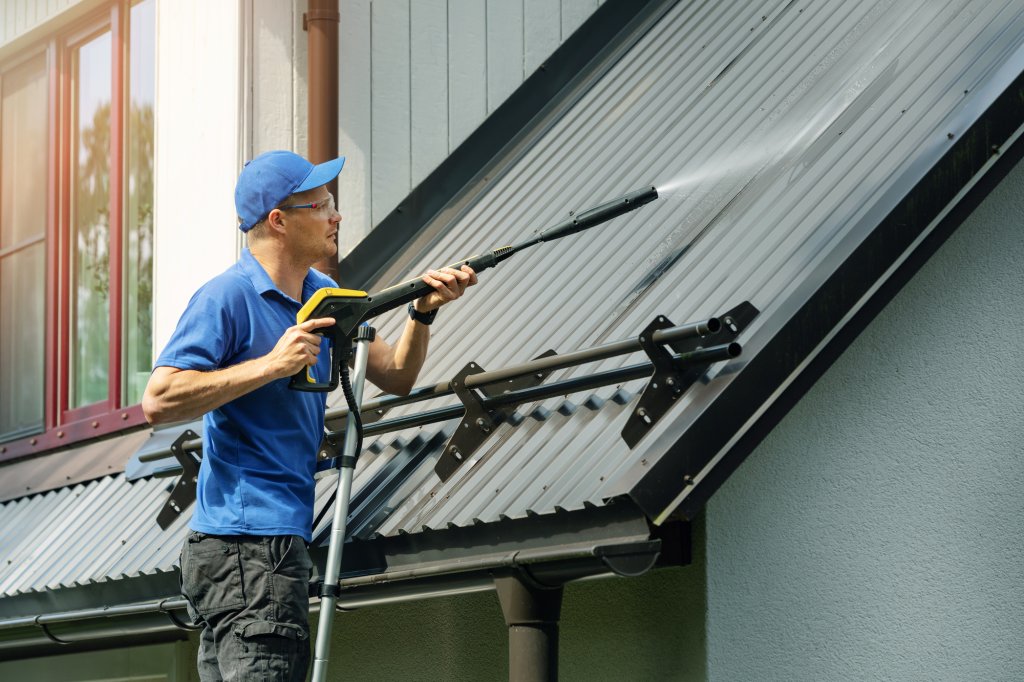Pressure washing the exterior of your home is not merely a cosmetic solution; it helps preserve the integrity of your property. Beyond boosting curb appeal, regular pressure washing safeguards your home against the corrosive effects of dirt, mold, mildew, and other contaminants—extending the lifespan of your exterior surfaces.
But how often should you pressure wash your home? There isn’t a one-size-fits-all answer. The frequency of pressure washing should be tailored to certain factors, which are elaborated below.
Location And Climate

Pressure washing should be done with major consideration of your location and local climate. Environmental factors affect the buildup of dirt, grime, mold, and algae on your home’s exterior.
- Damp, Rainy, Coastal Climates: Homes in these regions require more frequent cleaning than those in arid inland areas. It’s recommended to clean once or twice a year. Moisture and shade foster mold, algae, and mildew growth that stain siding and discolor masonry when left unchecked. If you face continual mildew battles, you can consult regional power washing companies, like Total Clean Pro-Wash, for frequency advice tailored to your specific climates and exteriors.
- Desert Climates: If you live in a desert climate, consider pressure washing once a year in early spring to remove built-up windblown dust and sand. You should also conduct monthly touch-up cleaning during the windiest seasons. Focus on areas that accumulate heavier drifts—like vents, corners, and AC units—which suffer more abrasion if left unchecked between annual washes. Sticking to this regimen keeps desert home exteriors looking better and avoids erosion damage from recurring sandy winds over time.
- Arid Inland Prairie Locations: Wash exteriors once every two to three years since lower humidity curtails mold and dirt accretion between periodic heavy pollen or dust blows. Schedule a full house cleaning during early spring once any winter residues appear, examining surfaces midyear for added trouble spot touch-ups as needed. Though less frequent due to climate, proper power washing every few years keeps prairie homes looking pristine.
Exterior Construction Materials
Wood, stucco, and composite siding finishes attract more dirt over time than vinyl, aluminum, or brick.

- Wood siding should be pressure washed annually or biannually in damp climates to control moisture damage and mildew.
- Durable stucco requires cleaning every two to four years, depending on climate and moisture, to prevent stains.
- Composite siding can withstand gentle power washing every three to four years to keep surfaces dust- and debris-free, but never use harsh chemicals that can harm any protective coating. Proper washing frequency per exterior siding material maintains aesthetic appeal and underlying integrity of the structure.
- Vinyl siding can better withstand weathering than wood, stucco, and cement surfaces. It can be power washed every four to five years to remove accumulated dust, mud, and environmental stains.
- Metal siding and architectural elements generally need cleaning at least every two to three years, as air pollution and acid rain particulates can oxidize and pit the material easily.
Appearance And Stains
Inspect all exterior home surfaces at least twice a year, especially siding, brick, stucco, and trim materials. Pressure wash as soon as dark streaks appear since they indicate the presence of mildew colonies. Also, address splattered insect debris before acidity damages delicate finishes.
Mind the window caulking, wood trim, lighting fixtures, and railings since grime buildup in crevices leads to deeper penetration over time. Catch problems early before stains have a chance to etch surfaces. More minor spot cleanings can prolong the need for overall house washes.
DIY Inspections

There are certain inspections you can do to assess your pressure washing needs. Grab a ladder to view gable peaks and upper-story areas. Here are some warning signs justifying prompt cleaning:
- Dark algae streaks under roof lines
- Pollen clumps surrounding vents or frames
- Leaves piled against the foundation
- Mold on steps and porch decking
- General dinginess and faded quality
Address identified trouble spots right away before lasting damage sets in. Schedule seasonal maintenance washes or hire reputable companies for prompt refreshing. Their roof detail packages guarantee full mold and mildew elimination.
Additional Cleaning Considerations
Homes flanked closely by trees or landscaping need extra pressure washing diligence. Prune back encroaching branches and regularly clear brush or leaf piles to minimize exterior dirt and dampness. Also, account for cleaning needs prompted by external AC systems, pool pumps, or propane tanks, which can become magnets for spider webs, pollen, and blowing lawn clippings. Adjust pressure wash schedules accordingly if installed.
Key Takeaways
Understanding what impacts exterior pressure washing frequency helps maintain curb appeal and structural integrity. Annual and biannual schedules for most regions are generally recommended, especially in areas prone to mold and mildew. Catch surface stains before they can dig in or spread across siding and masonry materials. Power washing a home’s exterior prevents damage and costly repairs down the road. So schedule your next pressure wash today!

